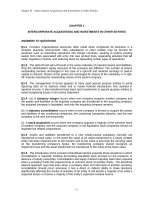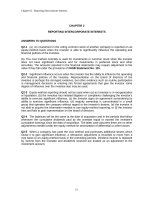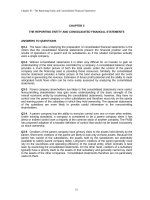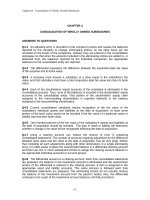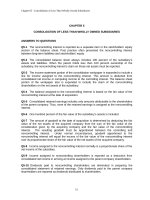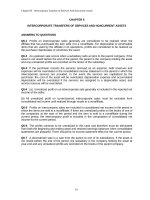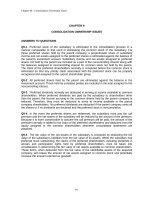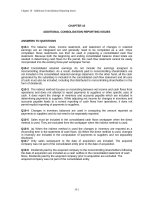Solution manual advanced financial accounting, 8th edition by baker chap012
Bạn đang xem bản rút gọn của tài liệu. Xem và tải ngay bản đầy đủ của tài liệu tại đây (330.59 KB, 78 trang )
Chapter 12 - Multinational Accounting: Issues in Financial Reporting and Translation of Foreign Entity
Statements
CHAPTER 12
MULTINATIONAL ACCOUNTING: ISSUES IN FINANCIAL REPORTING AND
TRANSLATION OF FOREIGN ENTITY STATEMENTS
ANSWERS TO QUESTIONS
Q12-1 Expected benefits of adopting a single set of high-quality accounting
standards include:
1. Continued expansion of capital markets across national borders.
2. Faster availability of financial statements that provide needed information to
investors in countries where standards have not previously focused on
information needs of investors.
3. More rapid development of stable, liquid capital markets.
4. Increased economic growth.
5. Improve ability of investors to evaluate opportunities across national borders.
6. Improve the efficient use of global capital.
7. Reduce reporting costs for corporations that wish to access capital in markets
outside of their home country.
8. Increase confidence of financial statement users in the quality of financial
reporting.
Q12-2 The IASB is an independent, privately funded accounting standards-setting
body. the mission of the IASB is to develop a single set of high-quality,
understandable, and enforceable global accounting standards.
The IASB is
composed of 14 members who each serve a five-year term subject to one
reappointment. Members are required to sever all employment relationships that
might compromise their independent judgement in setting accounting standards. The
IASB is based in London.
Q12-3 The IASB solicits input from the public when evaluating potential standards
and publishes a discussion paper and/or an exposure draft which are subject to
comment before issuing a final standard.
Q12-4 IFRS are already mandated or permitted in over 100 countries around the
world. Beginning with 2005, the European Union mandated the use of IFRS for
companies listing on stock exchanges in the EU, although the EU also continues to
accept statements prepared according to US GAAP. Beginning in 2008, foreign
private issuers who list their shares on US stock exchanges may use IFRS in their
financial statements without reconciliation to US GAAP.
Q12-5 The SEC is considering allowing US companies to use IFRS in their financial
reports. The SEC held roundtable discussions in December 2007. Among those
participating in the roundtable, there was overwhelming support for adopting for the
use of a single of global standards, and the majority of the panellists agreed that
IFRS ultimately will be the standard. There was general agreement among
roundtable participants that the SEC should specify a date by which US issuers would
be required to prepare financial statements in accordance with IFRS. The target date
most often mentioned should conversion be required is 2011, to coincide with the
adoption of IFRS by a number of other countries including Canada and India.
12-1
Chapter 12 - Multinational Accounting: Issues in Financial Reporting and Translation of Foreign Entity
Statements
Q12-6
• Improve global competitive position of US corporations.
• Increase the quality of information available to investors.
• Reduce costs of compliance for companies that are currently using multiple
reporting frameworks.
• Enhance global capital markets.
• Companies would have easier access to raising capital in the global markets.
• Because SEC now permits foreign private issuers to file their financial reports
using IFRS without reconciliation, not allowing US companies to report under
IFRS could result in US companies bearing costs not incurred by foreign
private issuers.
• Enhance comparability across companies for users. SEC chairman Cox
noted that two-thirds of US investors own securities of foreign companies, a
30 percent increase in the last five years.
Q12-7 a. Local currency unit. The local currency unit (LCU) is the currency used
locally; that is, the currency used in the country in which the company is located.
b. Recording currency. The recording currency is the currency used to record the
economic activities in the journals and ledger of the business entity. The recording
currency is typically the local currency, but may be some other currency.
c. Reporting currency. The reporting currency is the currency used on the financial
statements of the business entity. Typically, the reporting currency is the same as the
recording currency.
Q12-8 The functional currency is normally the currency in which the foreign entity
performs most of its cash functions. However, for entities operating in highly
inflationary economies, the functional currency is designated as the U.S. dollar
regardless of the actual currency used for cash functions. The definition of a highly
inflationary economy is one that has a cumulative inflation of approximately 100
percent or more over a 3-year period. FASB 52 provides six indicators to be used to
determine a foreign entity's functional currency: (1) cash flows, (2) sales prices, (3)
sales markets, (4) expenses, (5) financing, and (6) intercompany transactions and
arrangements. If most of these indicators take place in the foreign currency unit, then
the FCU is the functional currency. If most take place in the U.S. dollar, then the dollar
is the functional currency.
Q12-9 Harmonization means to standardize the accounting principles used around
the world. For example, the U.S. does not allow a company to revalue its own assets
for the effects of inflation. Several countries do, however, allow for this revaluation
and subsequent depreciation on the revaluation. Differences in accounting principles
from country to country make it difficult to compare business entities doing business
in different countries. The harmonization of accounting principles around the world
would eliminate many of the problems of combining and consolidating multinational
entities. A U.S. company with international investments could then be assured of
essentially the same accounting principles being applied; therefore, revenues, profits,
and investments in these foreign investments could effectively be compared and
contrasted.
12-2
Chapter 12 - Multinational Accounting: Issues in Financial Reporting and Translation of Foreign Entity
Statements
Q12-10 When the local currency is the foreign entity's functional currency, the
translation method is used to convert the foreign entity's financial statements into U.S.
dollars, the parent company's reporting currency. The translation method uses the
current exchange rate for converting all assets and liabilities. The appropriate
historical exchange rate is used to convert the Canadian entity's stockholders' equity
accounts. The weighted average exchange rate is used to convert the Canadian
entity's income statement accounts. The change in the translation adjustment during
the period is reported as an element of other comprehensive income on the
Statement of Comprehensive Income, and is then accumulated with the other
elements of comprehensive income and reported within the stockholders’ equity
section of the consolidated balance sheet. The translation adjustment may have a
debit or credit balance, depending on the relative change in the exchange rate since
the parent acquired the subsidiary.
Q12-11 Remeasurement is used when the U.S. dollar is the functional currency of
the foreign entity. Furthermore, FASB 52 requires that the financial statements of
foreign entities operating in highly inflationary economies be remeasured as if the
functional currency were the reporting currency. Remeasurement requires the use of
the current exchange rate to convert all monetary assets and liabilities. The historical
exchange rate is used to convert nonmonetary assets and the stockholders' equity
accounts. The appropriate historical rate is the rate on the later of the two following
dates: (1) the day the foreign entity obtained the asset or the day the foreign entity
made a transaction affecting the stockholders' equity section such as selling
additional stock or declaring dividends, or (2) the day the U.S. parent company
purchased the foreign affiliate. In the case of a pooling of interests, the appropriate
historical rate is the rate for the day the foreign affiliate transacted to obtain the asset
or transacted in a stockholders' equity item.
The weighted average exchange rate for the period covered by the income statement
is used for revenues or expenses incurred evenly over the period except for those
expenses that are allocations of balance sheet items, such as depreciation, cost of
goods sold (inventories), or write-offs of goodwill. For cost allocations, the same rate
used on the balance sheet to convert the items to U.S. dollars is used on the income
statement.
Q12-12 Translation adjustments are the balancing items to make the debit and
credit items equal in the translated trial balance measured in U.S. dollars. The parent
company records its share of the translation adjustment in its books through an
adjusting entry. The change during the period in the translation adjustment is reported
as a component of other comprehensive income in the Statement of Comprehensive
Income. The accumulated other comprehensive income is reported as a separate
item of stockholders’ equity in the balance sheet. The cumulative translation
adjustment may have a debit balance or credit balance. A debit balance usually
means that the current exchange rate is less than the historical rate used to translate
the stockholders’ equity accounts. This means the dollar is strengthening relative to
the foreign currency. A credit balance usually results when the dollar is weakening
relative to the foreign currency, and the current exchange rate is higher than the
historical exchange rate.
Q12-13 The remeasurement gain or loss first appears as the trial balance balancing
item in the income statement section of the foreign affiliate's trial balance. The parent
company recognizes its share of the remeasurement gain through an adjusting entry.
Typically, the remeasurement gain is shown in the "Other Income" section of the
consolidated income statement.
12-3
Chapter 12 - Multinational Accounting: Issues in Financial Reporting and Translation of Foreign Entity
Statements
Q12-14 The stockholders' equity accounts are translated at the historical rate in
effect the date the parent company acquired the foreign affiliate because this aids in
the elimination entry process used to prepare the consolidated statements. The
investment account on the parent company's books includes the initial investment
measured in terms of the exchange rate on the date the parent purchased the foreign
affiliate. Thus, the basic eliminating entry to eliminate the investment account against
the capital stock and additional paid-in capital includes accounts with the same
currency measurement rate. The retained earnings include the effects of revenue and
expense transactions, all measured at different rates over time. The beginning
translated retained earnings, as measured in U.S. dollars, is taken from last year's
ending retained earnings. Net income is obtained from the income statement and
dividends are translated using the exchange rate in effect the date the dividends are
declared.
Q12-15 The current rate method uses the current exchange rate to translate the
foreign affiliate's assets and liabilities. The weighted-average exchange rate is used
to translate the foreign affiliate's revenues and expenses. This means that the
relationships within the assets and liabilities of the foreign affiliate's balance sheet are
not changed in the translation process. For example, the current ratio in U.S. dollar
statements will be the same as in the foreign currency statements. This results from
the use of a constant translation multiplier within the financial statements. However,
this relationship does not hold when computing ratios using a balance sheet account
and an income statement account: for example, return on equity. These ratios include
accounts with different translation exchange rates.
Q12-16 The excess of cost over book value has two effects: (1) the portion amortized
for the period is reported in the income statement, and (2) the unamortized balance is
reported in the balance sheet. When the local currency unit is the functional currency,
the translation method is used to convert the foreign entity's financial statements into
U.S. dollars. FASB 52 requires that the differential be evaluated in terms of the
foreign currency unit. Therefore, the period's amortization, measured in the foreign
currency, is translated at the weighted average exchange rate. The remaining
unamortized differential is translated at the current exchange rate at the end of the
period. The different exchange rates used typically result in a difference when
measured in U.S. dollars. This difference becomes part of the translation adjustment.
Q12-17 The change during the period in the translation adjustment is reported as a
component of other comprehensive income. The translation adjustment is part of the
accumulated other comprehensive income that is reported in the stockholders’ equity
section of the consolidated balance sheet.
Q12-18 Not all foreign subsidiaries are consolidated. The parent must be able to
exercise control over the foreign subsidiary's operating and financial policies before
consolidation is proper. This may not be the case if the foreign subsidiary is located in
a country in which the government places significant restrictions on dividend
declarations, input from non-local management, or other operating or financing
aspects of the business.
Q12-19 A recent Accounting Trends and Techniques indicated that approximately
one-quarter of the foreign subsidiaries of U.S. companies are not consolidated;
instead, they are reported as a long-term investment on the U.S. company's financial
12-4
Chapter 12 - Multinational Accounting: Issues in Financial Reporting and Translation of Foreign Entity
Statements
statements, usually under the equity method. The cost method is used to account for
the foreign investment, however, if the U.S. investor is not able to exercise significant
influence over the foreign investee's operating and financial policies.
Q12-20* The issue with intercompany transactions is with regard to the amount of
unrealized profit. The unrealized profit determined at the time of the initial
intercompany transaction is a function of the currency exchange rate at that time. As
the rate changes, the underlying accounts may be translated at different exchange
rates, thus affecting the computation of unrealized intercompany profit. FASB 52
states that the intercompany profit should be eliminated based on the exchange rate
at the date the intercompany transaction occurred. This eliminates any potential
problems from subsequent changes in exchange rates.
12-5
Chapter 12 - Multinational Accounting: Issues in Financial Reporting and Translation of Foreign Entity
Statements
SOLUTIONS TO CASES
C12-1 Comparison of US GAAP and IFRS
Research
PricewaterhouseCoopers offers a publication on its Web site,
Similarities and differences: A comparison of IFRS and US GAAP, that
provides a topic-based comparison. Access this publication on the
Web
at
/>pdf. On pages 4-11, there is a table of differences between US GAAP
and IFRS by reporting issue. There is also a reference to the pages in
the document where each of these items is explained in more detail.
Select any three of the items and read about the nature of the
differences. Prepare a short paper approximately two to three pages
long that defines the nature of the differences and discusses what you
have learned.
Solutions will vary by student depending on the particular items he or she
selects.
C12-2 Structure of the IASB
Research
The IASB Web site is www.iasb.org. At the top of the page, click on
the link About Us. Briefly describe the structure of the IASB.
Solution
The International Accounting Standards Committee (IASC) Foundation
is the parent entity of the IASB. The IASC Foundation is an
independent organization. The IASC Foundation trustees appoint the
IASB members, exercise oversight, and raise funds to support the
organization. The IASC Foundation also appoints the Standards
Advisory Council, which advises the IASB and the International
financial Reporting Interpretations Committee. The IASB has the sole
responsibility for setting accounting standards. These standards are
called International Financial Reporting Standards (IFRS).
C12-3 IASB Deliberations
Research
The IASB Web site is www.iasb.org. Access the Web site and click on
the link at the top of the page for Current Projects. On the Current
Projects page, click on the IASB link. You may also access this page
directly at
.
What are three projects on the active agenda that are being addressed
by the IASB? What is the timetable identified for milestones on each
of the projects? What is the status of the Conceptual Framework
project?
Solutions will vary by student depending on the particular items he or she
selects.
C12-4 Determining a Functional Currency
The choice of a functional currency is based on the currency used for six criteria
12-6
Chapter 12 - Multinational Accounting: Issues in Financial Reporting and Translation of Foreign Entity
Statements
provided in FASB Statement No. 52, as follows: (1) cash flows, (2) sales prices, (3)
sales markets, (4) expenses, (5) financing, and (6) intercompany transactions and
arrangements. The choice of a functional currency is made by management after a
subjective evaluation of these criteria. However, the U.S. dollar is specified as the
functional currency in cases in which the foreign affiliate of a U.S. company is located
in a country experiencing high inflation (approximately 100 percent or more over a
three-year period).
Foreign Entity's
Reporting Currency
1.
Argentinean peso
Foreign Entity's
Functional Currency
U.S. dollar
Process of
Restatement into
U.S. Dollars
Remeasurement
Note: This case shows that the U.S. dollar is the specified functional currency
for foreign subsidiaries located in countries with highly inflationary economies.
2.
Mexican pesos
Either peso or
dollar, management
may select either.
Either
Note: This case indicates that the criteria are not always absolute. Management
probably would select the specific functional currency on the basis of financial
effects, such as effect on earnings per share.
3.
British pound
British pound
Translation
4.
Swiss franc
European euro
Remeasurement
from franc to
euro; then
translation
from euro
to dollars
Note: This case shows that the local currency of the country in which the
foreign affiliate is located may not be the foreign affiliate's functional currency;
instead, a third currency presents the functional currency.
12-7
Chapter 12 - Multinational Accounting: Issues in Financial Reporting and Translation of Foreign Entity
Statements
C12-5
Principles of Consolidating and Translating Foreign Accounts
[AICPA Adapted]
a. The rules for consolidating a foreign subsidiary are essentially the same as for a
domestic subsidiary. The key element is the degree of control Petie Products has
over the financial and operating policies of Cream, Ltd. Typically, a 90 percent stock
ownership level would assure the parent company's control of the subsidiary. It is
possible, however, that the country of Kolay may have severe restrictions on the
decision-making abilities of non-Kolay investors, or that Kolay may have restrictive
laws regulating commerce within Kolay. Petie Products' management must evaluate
their ability to control the foreign subsidiary. If they do possess the necessary level of
control, the foreign subsidiary should be consolidated. If not, then the foreign
subsidiary is reported as an investment on the parent company's financial statements.
b. Translation means that the local currency unit is functional. The foreign
subsidiary's assets and liabilities are translated using the current exchange rate at the
end of 20X7. The stockholders' equity accounts are translated at appropriate
historical rates. The income statement accounts are translated at the weighted
average exchange rate during 20X7.
The appropriate exchange rates for each of the 10 items are presented below:
1. Current exchange rate at December 31, 20X7
2. Current exchange rate at December 31, 20X7
3. Current exchange rate at December 31, 20X7
4. Current exchange rate at December 31, 20X7
5. Current exchange rate at December 31, 20X7
6. Historical exchange rate at January, 20X4
7. Beginning Retained Earnings is carried forward as a composite from prior
years' operations. The beginning Retained Earnings is the prior period's ending
Retained Earnings.
8. Average exchange rate for 20X7 (assumes revenues earned evenly throughout
year)
9. Average exchange rate for 20X7
10. Average exchange rate for 20X7
12-8
Chapter 12 - Multinational Accounting: Issues in Financial Reporting and Translation of Foreign Entity
Statements
C12-6 Translating and Remeasuring Financial Statements of Foreign
Subsidiaries [AICPA Adapted]
a. The objectives of translating a foreign subsidiary's financial statements are to:
1. Provide information that is generally compatible with the expected economic
effects of a rate change on a subsidiary's cash flows and equity.
2. Reflect the subsidiary's financial results and relationships in single currency
financial statements, as measured in its functional currency and in conformity
with generally accepted accounting principles.
b. Applying different exchange rates to the various financial statement accounts
causes the restated financial statements to be unbalanced. ‘Unbalanced’ means that
the debits will not equal the credits in the subsidiary's trial balance prepared in U.S.
dollars. The amount required to bring the restated financial statements into balance is
termed the gain or loss from the translation or remeasurement. The gain or loss from
remeasuring Wahl A's financial statements is reported in the consolidated income
statement. The gain or loss arising from translating Wahl F's financial statements
(described as a translation adjustment) is reported as a component of comprehensive
income and then accumulated with other comprehensive income items and reported
under stockholders' equity in the consolidated balance sheet.
c. The functional currency is the foreign currency or the parent's currency that most
closely correlates with the following economic indicators:
1. Cash flow indicators
2. Sales price indicators
3. Sales market indicators
4. Expense indicators
5. Financing indicators
6. Intercompany transactions and arrangement indicators
d. All accounts relating to Wahl A's equipment — the equipment, accumulated
depreciation, and depreciation expense accounts — are remeasured by using the
exchange rate prevailing between the U.S. and Australian dollars at the later of the
two following dates: (1) the date at which Wahl Co. acquired its investment in Wahl A,
or (2) the date(s) the equipment was purchased by Wahl A. This exchange rate is
referred to as the historical rate.
All accounts relating to Wahl F's equipment are translated by using the current
exchange rates prevailing between the U.S. dollar and the European euro. For the
equipment cost and the accumulated depreciation, the current exchange rate at
December 31, 20X5, should be used for translation. Depreciation expense is
translated at an appropriate weighted average exchange rate for 20X5.
12-9
Chapter 12 - Multinational Accounting: Issues in Financial Reporting and Translation of Foreign Entity
Statements
C12-7 Translation Adjustment and Comprehensive Income
a.
Statement of income for the year, for the subsidiary
Subsidiary
Statement of Income
Year Ended December 31, 20XX
Sales
Cost of Sales
Gross Profit
Operating Expenses
Income from Operations
Consolidated Net Income to Controlling Interest
b.
$ 560,000
(285,000)
$ 275,000
(140,000)
$ 135,000
$ 135,000
Statement of comprehensive income for the year, for the subsidiary
Subsidiary
Statement of Comprehensive Income
Year Ended December 31, 20XX
Consolidated Net Income to Controlling Interest
Other Comprehensive Income:
Translation Adjustment
Comprehensive Income
c.
$ 135,000
(12,000)
$ 123,000
Balance sheet as of December 31, for the subsidiary
Assets
Subsidiary
Balance Sheet
December 31, 20XX
Cash
Receivables
Inventories
Property, Plant, and Equipment (net)
Total Assets
Liabilities and Stockholders’ Equity
Current Payables
Long-Term Payables
Capital Stock
Retained Earnings
Accumulated Other Comprehensive Income:
Translation Adjustment
Total Liabilities and Stockholders’ Equity
$ 50,000
24,700
60,300
328,000
$ 463,000
$ 16,000
181,000
100,000
258,000
(92,000)
$ 463,000
Note: The end-of-year retained earnings ($258,000) is comprised of the January 1
balance of $135,000, plus net income of $135,000, less dividends of $12,000.
12-10
Chapter 12 - Multinational Accounting: Issues in Financial Reporting and Translation of Foreign Entity
Statements
C12-7 (continued)
d.
FASB Statement No. 130 allows for either the one-statement format for the
combined statement of income and comprehensive income, or the two-statement
format for a statement of income and a separate statement of comprehensive
income. Both formats must include all the elements of comprehensive income.
The one-statement format presents the other comprehensive income elements
immediately below net income.
The two-statement format presents a separate statement of income as was done
prior to FASB 130. The statement of income ends with net income. Then, a
separate statement of comprehensive income begins with net income, followed
with the elements of other comprehensive income, and ends with comprehensive
income.
12-11
Chapter 12 - Multinational Accounting: Issues in Financial Reporting and Translation of Foreign Entity
Statements
C12-8 Changes in the Cumulative Translation Adjustment Account
Johnson & Johnson Company applied the concepts presented in the chapter for
translating the trial balances of its foreign subsidiaries. The resulting cumulative
translation adjustment has changed dramatically from a credit balance of $134 million
at the end of 20X1 to a debit balance of $338 million at the end of 20X3.
The translation adjustment is related to the translated net asset balance (assets
minus liabilities) of the foreign subsidiaries. Several factors could account for the
decrease in the net assets of Johnson & Johnson's foreign subsidiaries, as follows:
1. The foreign subsidiaries could be increasing their local liabilities, i.e., taking out
more local debt.
2. The foreign subsidiaries could be decreasing their local assets, i.e., not
maintaining their physical capital through reinvestment.
3. The direct exchange rate of the dollar versus the local currency units of the
countries in which the company has foreign subsidiaries has been decreasing
over time (i.e., the dollar had strengthened versus the local currency units).
Question d. can be used to demonstrate these factors. Remember that it is assumed
that the translated stockholders' equity, other than the accumulated other
comprehensive income (AOCI) from the translation adjustment, remained constant at
$500 million for each of the three years. The following condensed balance sheets can
be presented:
20X1 Translated Balance Sheets of All Foreign Subsidiaries
Net assets
$634
Stockholders’ equity:
Other than AOCI
AOCI Translation
Adjustment
$ 500
134
20X2 Translated Balance Sheets of All Foreign Subsidiaries
Net assets
$354
Stockholders’ equity:
Other than AOCI
AOCI Translation
Adjustment
$ 500
(146)
20X3 Translated Balance Sheets of All Foreign Subsidiaries
Net assets
$162
Stockholders’ equity:
Other than AOCI
AOCI Translation
Adjustment
12-12
$ 500
(338)
Chapter 12 - Multinational Accounting: Issues in Financial Reporting and Translation of Foreign Entity
Statements
C12-8 (continued)
If the direct exchange rate decreased over the two-year period, the translated net
assets would decrease, thus causing a decrease (debit change) in the translation
adjustment. The direct exchange rate would decrease if the dollar were strengthening
versus the local currency units of the countries in which the company had foreign
subsidiaries. Other causes for the decrease in the translated net assets would be a
decrease in local assets, or an increase in local liabilities.
Johnson & Johnson Company did make several changes in its foreign investment
portfolio during 20X2 and 20X3 that would have resulted in a change in the combined
stockholders' equity of the company's foreign investments. During 20X3, the company
acquired approximately $266 million in European companies. In 20X2, the company
acquired approximately $47 million in Japanese companies. The company completed
relatively minor sales of foreign subsidiaries and operations during 20X2 and 20X3.
Thus, it appears that the major reasons for the significant debit change in the
accumulated other comprehensive income — translation adjustment account over the
two-year period was that the foreign subsidiaries were increasing their local debt, and
that the U.S. dollar was strengthening versus the local currency units of the foreign
countries in which Johnson & Johnson Company had subsidiaries. A more specific
analysis would require knowledge of the amount of the foreign investments in each
country, the balance of the local assets and local liabilities of each of the foreign
subsidiaries, and the knowledge of the exchange rates for the dollar versus the
foreign currencies of the countries in which the company has invested.
12-13
Chapter 12 - Multinational Accounting: Issues in Financial Reporting and Translation of Foreign Entity
Statements
C12-9 Pros and Cons of Foreign Investment
The focus of this case is to consider the variables involved with the business decision
of expanding a company's production and/or marketing investment in a foreign
country. Many of the variables would be similar to those considered in the decision to
increase a company's physical capital in the U.S. But, some additional variables
should be considered for the foreign country such as: home-country laws, the political
and economic environment, the accounting and tax laws, the status of labor
organization, the cost-of-living and prevailing wages, the supply of trained labor
forces (including local management personnel), and the different cultural aspects that
might impact on obtaining the factors of production or on the markets for the
company's goods. Some companies make investment in foreign production facilities
in order to have a production capability closer to a foreign market. Thus transportation
costs of the finished goods are decreased, while the company is able to increase
overall revenue and income.
Many companies go to non-U.S. production sources because of the lower costs for
labor. Thus, if the company produces a labor-intensive product, the economics of the
decision may favor foreign production. In addition, as tariffs are reduced, U.S.
companies may find it more advantageous to move their production facilities to nonU.S. locations. One possible outcome is that the costs of the finished goods to U.S.
consumers would be lower for goods manufactured outside the U.S. However, an
argument often raised in the political arena is that unemployed U.S. consumers would
not be able to purchase the products.
The U.S. government has proposed retraining programs for dislocated workers who
lose their jobs because the company has closed the U.S. production facility. Students
should be encouraged to develop some new and novel approaches to solving the
problem of the general change in the types of new jobs being created in the U.S.
economy.
12-14
Chapter 12 - Multinational Accounting: Issues in Financial Reporting and Translation of Foreign Entity
Statements
C12-10 Determining an Entity’s Functional Currency
MEMO
To: Garry Parise, CFO, Maxima Corporation
From:
_______________
Department
Re:
____________________,
CPA,
Controller’s
Functional Currency of Luz Maxima
According to FASB Statement No. 52, the functional currency for a company is the
primary currency that is generated by cash inflows and used for cash outflows.
Further, it is the currency the country that is primary economic environment of the
company’s business operations as indicated by items such as sales, and expense,
and financing activities.
Because Luz Maxima initially did business exclusively with Maxima Corporation and
these transactions were denominated in the U.S. dollar, its functional currency was
originally determined to be the U.S. dollar. However, it appears that changes in Luz
Maxima’s operation over the past five years may result in a change in the functional
currency from the U.S. dollar to the Mexican peso.
Appendix A of FASB 52 provides indicators that should be considered in determining
a foreign subsidiary’s functional currency. Among the indicators that may be relevant
for evaluating the functional currency of Luz Maxima are sales, expense, and
financing indicators.
• Sales market indicators – Luz Maxima now sells a significant amount of product
in Mexico and South America. These transactions are denominated in the peso.
• Expense indicators – Luz Maxima obtains a significant amount of materials from
local suppliers.
• Financing indicators – Luz Maxima obtained long-term debt financing and a line of
credit from banks in Mexico.
To the extent indicators are mixed and Luz Maxima also has sales, expenses, and
financing transactions denominated in the U.S. dollar, FASB 52 states that
management should make the final determination as to the functional currency.
FASB 52 also indicates that, while it is desirable for the functional currency to be used
consistently, if economic facts change, it may be appropriate to change the
determination of the functional currency.
Management should assess all aspects of Luz Maxima’s operation to determine the
most appropriate and relevant functional currency for this subsidiary. If a decision is
made to change the functional currency from the U. S. dollar to the Mexican peso,
Luz Maxima’s current financial statements should be converted to U.S. dollars using
the current rate translation method. Any adjustment that occurs as a result of
translating nonmonetary assets using the current rate method should be reported as
a component of other comprehensive income.
12-15
Chapter 12 - Multinational Accounting: Issues in Financial Reporting and Translation of Foreign Entity
Statements
C12-10 (continued)
Authoritative support for the above memo can be found in the following references:
FASB 52, Par. 5, Par. 9, Par. 41, Par. 42, Par. 46
Suggested Query:
functional currency*
C12-11 Accounting for the Translation Adjustment
MEMO
To: Renee Voll, Controller
From:
___________ _______________, CPA
Re: Translation Adjustment for Valencia subsidiary
Since Sonoma has sold 30% of the investment in our Spanish subsidiary, the balance
of the cumulative translation adjustment, included in consolidated stockholders’
equity, should be reduced proportionately.
FASB Statement No. 52 normally does not require that changes in the translation
adjustment be included in earnings. Prior to the liquidation of an investment in a
subsidiary, the FASB believes that the effects of such translation adjustments are
uncertain and should not be included in income. However, when there is a sale or
liquidation of a subsidiary, the amount of the translation adjustment that is included in
equity should be removed from equity and should be reported as part of the gain or
loss in the period in which the transaction occurs.
Although Sonoma has not completely liquidated the investment in Valencia, the
company is still required to recognize a portion of the translation adjustment in
computing the gain or loss. According to FIN 37, a pro rata portion of the
accumulated translation adjustment that is attributable to the subsidiary must be
included in the calculation of the gain or loss on the sale of a portion of the subsidiary.
Therefore, the gain on the sale of the Valencia investment should be reduced by 30%
of the (debit balance) cumulative translation adjustment related to this investment.
Sonoma should disclose the amount by which the gain is decreased because of the
adjustment for the cumulative translation adjustment.
In the presentation of comprehensive income, the adjustment to the translation
adjustment should be identified as a reclassification adjustment so that the same
amount is not included in both net income and in comprehensive income.
12-16
Chapter 12 - Multinational Accounting: Issues in Financial Reporting and Translation of Foreign Entity
Statements
C12-11 (continued)
Authoritative support for the above memo can be found in the following references:
FASB 52, Par. 14, Par. 31, Par. 111
FASB 130, Par. 19
FIN 37, Par. 2
Suggested Query:
translation adjustment* sale
12-17
Chapter 12 - Multinational Accounting: Issues in Financial Reporting and Translation of Foreign Entity
Statements
SOLUTIONS TO EXERCISES
E12-1 Multiple-Choice Translation and Remeasurement [AICPA Adapted]
Foreign Currency
is Functional Currency
1.
a.
U.S. Dollar
is Functional Currency
$215,000
b.
$225,000
($100,000 + $50,000 + $30,000
+ $45,000)
2.
c.
400,000 LCU x $.44 = $176,000
d.
120,000 LCU x $.50
80,000 LCU x $.44
200,000 LCU x $.44
3.
a.
Indirect rates used
c.
170,000 LCU / 1.5 LCU
90,000 LCU / 1.6 LCU
= $113,333
= 56,250
$169,583
b.
25,000 LCU / 2.2 LCU
= $ 11,364
260,000 LCU / 1.8 LCU = $144,444
4.
d.
25,000 LCU / 2 LCU = $12,500
5.
a.
d.
6.
a.
c.
7.
a.
$755,000
d.
(All assets are translated
at current rate)
= $ 60,000
= 35,200
= 88,000
$183,200
$880,000
($85,000 + $700,000 + $25,000
+ $70,000)
12-18
Chapter 12 - Multinational Accounting: Issues in Financial Reporting and Translation of Foreign Entity
Statements
E12-2Multiple-Choice Questions on Translation and Foreign Currency
Transactions [AICPA Adapted]
Foreign Currency
is Functional Currency
1. b.
U.S. Dollar
is Functional Currency
$10,000
d.
$120,000 = 2/15/X2 $ value
(110,000) = 12/31/X1 $ value
$ 10,000 = Foreign exchange
gain
2. d.
$10,000 = Foreign currency
transaction gain
30,000 = Remeasurement gain
$40,000 = Foreign exchange
gain
$17,000
b.
$13,000 = Preadjusted foreign
exchange loss
4,000 = Foreign currency
transaction loss
($60,000 - $64,000)
$17,000 = Foreign exchange
loss
3. c.
$21,000
$10,000
$13,000 = Preadjusted foreign
exchange loss
4,000 = Foreign currency
transaction loss
(7,000) = Remeasurement gain
$10,000 = Net foreign
exchange loss
a.
$15,000 = Preadjusted foreign
exchange loss
6,000 = Foreign currency
transaction loss
($100,000 $106,000)
$21,000 = Foreign exchange
loss
4. a.
$40,000
$41,000
$15,000 = Preadjusted foreign
exchange loss
6,000 = Foreign currency
transaction loss
20,000 = Remeasurement gain
$41,000 = Net foreign
exchange loss
When the remeasurement method is used, monetary accounts are restated at
the exchange rate at the balance sheet date, while nonmonetary accounts are
restated using the exchange rate(s) at the date(s) the transaction(s) occurred
which are reflected in the account balance. In this question, bonds payable and
accrued liabilities are both monetary accounts and would be restated using the
balance sheet exchange rate. Trading securities represent a nonmonetary
account. Trading securities would be restated using the balance sheet rate
because the account balance is stated at the market values at the balance
sheet date. Inventories are also a nonmonetary asset. Since they are stated at
cost, a historical exchange rate would be used to restate inventories.
12-19
Chapter 12 - Multinational Accounting: Issues in Financial Reporting and Translation of Foreign Entity
Statements
E12-2 (continued)
5.
b. The current rate method of translation allows the use of a weighted average
exchange rate for revenues and expenses that occur throughout the year. Since
both sales and wages expense occur throughout the year, a weighted average
exchange rate can be used for translation.
6.
a. For hedges of net investments in a foreign entity, the amount of the change in
fair value of the hedging instrument is recorded to other comprehensive income
that then becomes part of the accumulated other comprehensive income. The
change in the translation adjustment during the period is reported as a
component of other comprehensive income and then carried forward to be
accumulated in the stockholders’ equity section of the balance sheet with the
other components of other comprehensive income. Therefore, in this case in
which a hedge of a net investment in a foreign entity is used, the exchange gain
on the hedge is reported along with the change in the translation adjustment.
E12-3 Matching Key Terms
1.
H
2.
G
3.
F
4.
D
5.
E
6.
B
7.
C
8.
B
9.
D
10.
E
11.
J
12.
C
12-20
Chapter 12 - Multinational Accounting: Issues in Financial Reporting and Translation of Foreign Entity
Statements
E12-4 Multiple-Choice Questions on Translation and Remeasurement
1.
2.
B
Investment cost
Less:
Book and fair values of sub's net assets
680,000 ringitts x $.21 x .90 =
Goodwill
C
Goodwill
Impairment
Dollars
$10,500
1,100 (RM 5,000 x $.22)
3.
A
Impairment loss = $10,500 / 10 = $1,050
4.
A
€ 25,000 x $1.24 = $31,000
5.
D
€ 5,000 x $1.30 = $6,500
6.
C
Investment cost on January 1, 20X5
Less:
Book and fair values of sub’s net assets:
€ 300,000 x $1.20
Goodwill
Goodwill
Impairment
Balance
Dollars
$42,000
4,340 (€ 3,500 x $1.24)
$37,660
Translated
balance
$41,580 (€ 31,500 x $1.32)
$160,000
128,520
$ 31,480
Ringitts
RM 50,000 ($10,500 / $.21)
5,000 (RM 50,000 / 10)
$402,000
360,000
$ 42,000
Euros
€ 35,000 ($ 42,000 / $1.20)
3,500 (€ 35,000 / 10)
€ 31,500
Translation adjustment: $41,580 minus $37,660 = $3,920 – use for
question 7.
7.
B
Translation adjustment from
translating the trial balance
Translation adjustment from
translating goodwill
Total translation adjustment
$12,000cr
3,920cr
$15,920cr
12-21
Chapter 12 - Multinational Accounting: Issues in Financial Reporting and Translation of Foreign Entity
Statements
E12-5 Translation
RoadTime Company
Trial Balance Translation
December 31, 20X1
Swiss
Francs
Translation
Rate
U.S.
Dollars
Cash
Accounts Receivable (net)
Receivable from Popular Creek
Inventory
Plant and Equipment
Cost of Goods Sold
Depreciation Expense
Operating Expense
Dividends Paid
Total Debits
SFr
7,000
20,000
5,000
25,000
100,000
70,000
10,000
30,000
15,000
SFr 282,000
.80
.80
.80
.80
.80
.75
.75
.75
.77
$ 5,600
16,000
4,000
20,000
80,000
52,500
7,500
22,500
11,550
$219,650
Accumulated Depreciation
Accounts Payable
Bonds Payable
Common Stock
Sales
Total
Accumulated Other Comprehensive
Income — Translation
Adjustment (credit)
Total Credits
SFr 10,000
12,000
50,000
60,000
150,000
SFr 282,000
.80
.80
.80
.73
.75
$ 8,000
9,600
40,000
43,800
112,500
$213,900
5,750
$219,650
12-22
Chapter 12 - Multinational Accounting: Issues in Financial Reporting and Translation of Foreign Entity
Statements
E12-6 Proof of Translation Adjustment
a.
Popular Creek Corporation and Subsidiary
Proof of Translation Adjustment
Year Ended December 31, 20X1
Net assets at beginning of year
Adjustment for changes in net
asset position during year:
Net income for year
Dividends paid
Net assets translated at:
Rates during year
Rates at end of year
SFr
Translation
Rate
SFr 60,000
.73
$ 43,800
40,000
(15,000)
.75
.77
30,000
(11,550)
SFr 85,000
.80
$ 62,250
68,000
Change in other comprehensive
income translation adjustment during year net increase
Accumulated other comprehensive
income — translation adjustment —
January 1
$ 5,750
-0-
Change in other comprehensive income —
translation adjustment
December 31 (credit)
b.
U.S.
Dollars
$ 5,750
The change in the translation adjustment of $5,750 is included as a credit in the
other comprehensive income on the Statement of Comprehensive Income. The
other comprehensive income is then accumulated and reported in the
stockholders’ equity section of the consolidated balance sheet.
Supporting computations:
Net income:
Sales
SFr 150,000
Net Assets
CGS
Depreciation
Oper. Expenses
Net Income
(70,000)
(10,000)
(30,000) Total
SFr 40,000
Balance Sheet, 12/31/X1
$68,000 Common Stock
$68,000
Ret. Earn.*
AOCI
Total
Retained earnings, 1/1/X1
Net income
Dividends
*Retained earnings,
12/31/X1
12-23
$
43,800
18,450
5,750
$ 68,000
$
-030,000
(11,550)
$ 18,450
Chapter 12 - Multinational Accounting: Issues in Financial Reporting and Translation of Foreign Entity
Statements
E12-7 Remeasurement
RoadTime Company
Trial Balance Remeasurement
December 31, 20X1
Swiss
Francs
U.S.
Dollars
Rate
Cash
Accounts Receivable (net)
Receivables from Popular Creek
Inventory
Plant and Equipment
Cost of Goods Sold
Depreciation Expense
Operating Expense
Dividends Paid
Total
Remeasurement Loss
Total Debits
SFr
7,000
20,000
5,000
25,000
100,000
70,000
10,000
30,000
15,000
SFr 282,000
.80
.80
.80
.77
.74
(a)
.74
.75
.77
$ 5,600
16,000
4,000
19,250
74,000
52,000
7,400
22,500
11,550
$212,300
1,000
$213,300
Accumulated Depreciation
Accounts Payable
Bonds Payable
Common Stock
Sales
Total Credits
SFr 10,000
12,000
50,000
60,000
150,000
SFr 282,000
.74
.80
.80
.73
.75
$
Swiss
Francs
(a) Cost of Goods Sold:
Beginning Inventory
Purchases
Goods Available for Sale
Less: Ending Inventory
Cost of Goods Sold
SFr
-095,000
SFr 95,000
(25,000)
SFr 70,000
12-24
7,400
9,600
40,000
43,800
112,500
$213,300
U.S.
Dollars
Rate
.75
.75
.77
$
-071,250
$ 71,250
(19,250)
$ 52,000
Chapter 12 - Multinational Accounting: Issues in Financial Reporting and Translation of Foreign Entity
Statements
E12-8* Proof of Remeasurement Gain (Loss)
a.
Popular Creek Corporation and Subsidiary
Proof of Remeasurement Loss
Year Ended Dec. 31, 20X1
Schedule 1
Statement of Net Monetary Position
Monetary Assets:
Cash
Accounts Receivable (net)
Receivables from Popular Creek
Total
Less Monetary Liabilities:
Accounts Payable
Bonds Payable
Total
Net Monetary Assets
End of
Year
Beginning
of Year
SFr 7,000
20,000
5,000
SFr 32,000
SFr 60,000
SFr 12,000
50,000
SFr(62,000)
SFr
SFr 60,000
-0-0SFr
-0SFr 60,000
Net Monetary Liabilities
SFr 30,000
Change in net monetary investment during 20X1
SFr (90,000)
Schedule 2
Analysis of Changes in Monetary Accounts
Exposed net monetary asset
Position – January 1
Adjustments for changes in the net
monetary position during the year:
Increases:
From operations:
Sales
From other sources
Decreases:
From operations:
Purchases
Cash expenses
From dividends
From purchase of
plant and equipment
Net monetary position prior to
remeasurement at year-end rates
Exposed net monetary liability
Position – December 31
Remeasurement loss
SFr
Exchange
Rate
U.S.
Dollars
SFr 60,000
.73
$ 43,800
150,000
-0-
.75
112,500
-0-
(95,000)
(30,000)
(15,000)
.75
.75
.77
(71,250)
(22,500)
(11,550)
(100,000)
.74
(74,000)
$(23,000)
SFr(30,000)
12-25
.80
(24,000)
$ (1,000)
